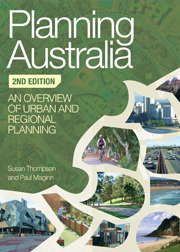Book contents
- Frontmatter
- Contents
- Contributors
- Figures and tables
- Discussion points and case studies
- Preface
- Acknowledgments
- Abbreviations
- Table of statutes
- Introduction
- Part I Frameworks
- Part II Key Issues
- 6 Planning and the natural environment
- 7 The metropolis
- 8 Planning for rural landscapes
- 9 Planning for regions
- 10 Planning for diverse communities
- 11 Aboriginal and Torres Strait Islander Australians
- 12 Community participation in planning
- 13 Urban design
- 14 Planning for heritage conservation and management
- 15 Transport planning
- 16 Healthy planning
- Conclusion: planning Australia into the future
- Index
- References
11 - Aboriginal and Torres Strait Islander Australians
from Part II - Key Issues
- Frontmatter
- Contents
- Contributors
- Figures and tables
- Discussion points and case studies
- Preface
- Acknowledgments
- Abbreviations
- Table of statutes
- Introduction
- Part I Frameworks
- Part II Key Issues
- 6 Planning and the natural environment
- 7 The metropolis
- 8 Planning for rural landscapes
- 9 Planning for regions
- 10 Planning for diverse communities
- 11 Aboriginal and Torres Strait Islander Australians
- 12 Community participation in planning
- 13 Urban design
- 14 Planning for heritage conservation and management
- 15 Transport planning
- 16 Healthy planning
- Conclusion: planning Australia into the future
- Index
- References
Summary
Key terms: Aboriginal and Torres Strait Islander people; cultural blindness; cultural difference; extinguish; land-use planning; land and sea country; native title; terra nullius; traditional owner.
There are two laws. Our covenant and white man’s covenant, and we want these two to be recognised … We are saying we do not want one on top and one underneath. We are saying that we want them to be equal. (David Mowaljarlai, Elder, Ngarinyin people, Western Australia, 1997)
Throughout Australia, it is widely accepted that community members affected by contemporary land-use planning processes and environmental decision-making will be able to participate in such activities because they affect the rate and type of development and hence the community’s amenity and well-being. Until very recently, however, this has not necessarily been true for Aboriginal and Torres Strait Islander people, who have negligible involvement in planning processes and decision-making affecting their traditional country (Jackson 1997b, p. 87), in part because of the cultural blindness characteristic of conventional planning practices.
Such practices have been shaped by many of the assumptions underpinning the history of white colonisation of Australia, particularly the belief that Australia was terra nullius, or land belonging to nobody. Since Mabo v State of Queensland (No. 2) (1992) 175 CLR 1 (Mabo (No. 2)), this assumption is no longer tenable. Instead, planners must recognise that Aboriginal and Torres Strait Islander people have strong and continuing connections to land and sea country.
- Type
- Chapter
- Information
- Planning AustraliaAn Overview of Urban and Regional Planning, pp. 254 - 275Publisher: Cambridge University PressPrint publication year: 2012
References
- 6
- Cited by

